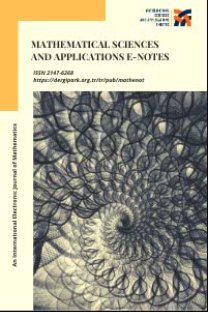EFFECT OF SHAPE TRANSFORMATION ACCOMPANIED BY M1 TRANSITIONS ON THE ENERGY WEIGHT SUM RULE
EFFECT OF SHAPE TRANSFORMATION ACCOMPANIED BY M1 TRANSITIONS ON THE ENERGY WEIGHT SUM RULE
-,
___
- Rowe, D.J., Nuclear collective motion. Methuen, London, 1970.
- Solovyov, V.G., Theory of complex nuclei. Pergamon Press, New York, 1976.
- Kuliev, A.A., et al, Double b-decay and neutrino mass. Bullet. of Acad. of Sci. USSR, Ser.Phys. 53 (1989) 2140-2144.
- Erbil, H., Gereklioglu, M., lhan, M. and Kuliev, A.A., Sum rule approach to nuclear collective vibration. Math. and Comp. Appl. 2 (1997) 1-11.
- Richter, A., Probing the nuclear magnetic dipole response with electrons, photons and hadrons. Prog. Part.Nucl.Phys 34 (1995) 261-284.
- Wood, J.L., et al, Coexistence in even-mass nuclei. Physics Reports 215 (1992) 101-201.
- Sarriguren, P., et al, Gamow-Teller strength distributions in Fe and Ni stable isotopes. Nucl. Phys. A 716 (2003) 230-244.
- Petrovichi, A., Scimid, K.W. and Faessler, A., Shape coexistence and shape transition in N ≃ Z nuclei from krypton to molybdenum. Nucl.Phys.A 605 (1996) 290-300.
- Berlovich, E.Ye. and Novikov, Yu.N., Probabilities of β-decay of nuclei in the transition region. Phys.Letters 19 (1965) 668-669.
- Thouless, D.J., Vibrational states of nuclei in the random phase approximation. Nucl. Phys. 22 (1961) 78-95.
- Gabrakov, S.I., et al, Collective 1 states in doubly even deformed nuclei. Nucl. Phys. A 182 (1972) 625-633.
- Kuliev, A.A., et al, Rotational-invariant model of the states with Kn= 1+. Int. J. Mod. Phys. E 9 (2000) 249-261.
- Gabrakov, S.I., et al, States Ip= 1+in even-even deformed nuclei. Sov. Journ. of Nucl. Phys. 12 (1970) 82-90.
- Sveshnikov, A.G. and Tikhonov, A.N., The theory of functions of a complex variable. Nauka Moscow, 1971.
- Dudek, J. and Werner, T.J., New parameters of the deformed Woods-Saxon potential for A=110-210 nuclei. J. Phys. G: Nucl. Phys. 4 (1978) 1543.
- Bohr, O. and Mottelson, B., Nuclear Structure Vol. 2. NewYork, W.A. Benjamin, 1975.
- Raman, S., et al, At. Data Nucl. Data Tables 78 (2001) 1.
- Dietrich, K.-G., Humbert, F and Richter, A., Magnetic dipole strength distribution at high excitation energies in deformed nuclei. Phys. Lett. B 220 (1989) 351-355.
- Laszewski, R.M., et al, Giant M1 resonance in140Ce. Phys. Rev. C 34 (1986) 2013-2015.
- Enders, J., et al., Parameter-free description of orbital magnetic dipole strength. Phys. Rev. C 71 (2005) 014306.
- Sakarya University, Faculty of Arts and Sciences, Dept.of Mathematics, 54100 Sakarya-TURKEY
- ISSN: 2147-6268
- Yayın Aralığı: 4
- Başlangıç: 2013
- Yayıncı: -
THE RELATIONS AMONG INSTANTANEOUS ROTATION VECTORS OF A PARALLEL TIMELIKE RULED SURFACE
Cumali EKİCİ, Ü.ziyasavci, Yasinünlütürk
PARALLEL LINEAR WEINGARTEN SURFACES IN E3 AND E3-1
Yusuf YAYLI, Deryasağlam, Özgürkalkan
ON NADLER'S FIXED POINT THEOREM FOR PARTIAL METRIC SPACES
EFFECT OF SHAPE TRANSFORMATION ACCOMPANIED BY M1 TRANSITIONS ON THE ENERGY WEIGHT SUM RULE
REMARKS AND QUESTIONS ON BASE POSITIONAL DIMENSION-LIKE FUNCTIONS OF THE TYPE IND
